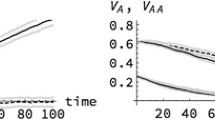Abstract
Quantitative traits are determined by variation at multiple polygenes and the environment. In this chapter, FORTUNA is modified to allow simulation of quantitative traits rather than sequence. We discuss the genetic components of genetic variance—including allele effects, dominance effects, and epistasis—and consider several models of two-locus epistasis. Significant modifications to FORTUNA code allow us to simulate neutral evolution of quantitative traits. Subsequently, we amend the code to allow simulation of selection on quantitative traits. Three distinct forms of selection are considered: (1) natural selection for an optimal phenotype using a Gaussian fitness function; (2) evolutionary constraints on phenotype; and (3) artificial selection in the form of truncation selection.
Access this chapter
Tax calculation will be finalised at checkout
Purchases are for personal use only
Similar content being viewed by others
Notes
- 1.
I stress that labeling one locus main and the other epistatic is not something you will find in the literature; these are labels of convenience for constructing FORTUNA only.
- 2.
The text immediately following this paragraph provides tips and R code for generating long lists of alleleEffects, dominanceEffects, and epistaticTypes. This is helpful when the number of causative loci is large.
- 3.
Author information
Authors and Affiliations
Rights and permissions
Copyright information
© 2022 Springer Nature Switzerland AG
About this chapter
Cite this chapter
Haasl, R. (2022). Quantitative Traits. In: Nature in Silico. Springer, Cham. https://doi.org/10.1007/978-3-030-97381-0_9
Download citation
DOI: https://doi.org/10.1007/978-3-030-97381-0_9
Published:
Publisher Name: Springer, Cham
Print ISBN: 978-3-030-97380-3
Online ISBN: 978-3-030-97381-0
eBook Packages: Biomedical and Life SciencesBiomedical and Life Sciences (R0)




